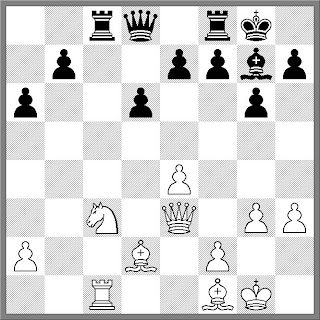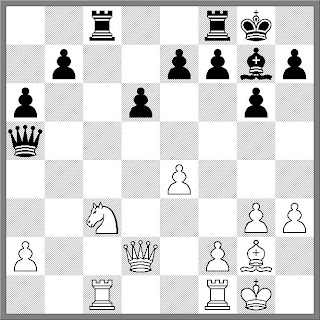


During a recent tournament game my opponent had an opportunity to centralise his knight and attack my queen in the process. Not an uncommon occurrence of course but I had already seen that best play would give him a chance to complicate matters by changing the material situation. There were actually two different sacrifices on the menu, one of a piece for two pawns plus some immediate threats and the other of two pieces for a rook and two pawns plus some longer-term positional factors.
Such ideas cannot be ignored or even dismissed because they may turn out to be dangerous. In this case I was able to analyse both sacrificial lines and make a choice that I think was clearly correct.
The first diagram shows the position after my last move 15.Rac1. Before playing this I had to take account of the reply 15...Ne5, when obviously the queen must move. The retreat 16.Qb1 looks far too passive and White should not consider 16.Qc2?! because of the freeing advance 16...b5! 17.cxb5 axb5 when the pawn cannot be captured because of the pin on White's knight. Thus there are two main variations: 16.Qe2 and 16.Qe3. Which is stronger?
After 16.Qe2 Nxc4!? 17.bxc4 Bxc4 18.Qe3 Bxf1 19.Bxf1(second diagram) Black has a rook and two pawns against White's bishop and knight. This material balance can be difficult to assess and this case is no exception. White will make progress if he can centralise his pieces and attack and win a pawn or two or especially if he can win back the exchange. Black will make progress if he can keep his pawn position intact and trade some pieces. A lone rook can easily dominate a bishop and knight if it also has weak pawns to attack and that is potentially the case here.
After 16.Qe3 Bxc4!? 17.bxc4 (and not 17.f4 because of Bxf1 winning the exchange) 17...Nxc4 18.Qe2 Nxd2 19.Qxd2 (third diagram) Black has given up a piece for two pawns. One of the challenges in assessing a position correctly is whether there are residual tactics to consider. After 19.Qxd2 Black can immediately pile up on White's knight with 19...Qa5 and it cannot move up to the key square d5 because White's queen is undefended. If White does not have a good reply to 19...Qa5 then he will have to allow the other sacrificial line by playing 16.Qe2. Fortunately, I was able to spot the proper answer to 19...Qa5, which is 20.Nb1! Black can play 20...Qxd2 21.Nxd2 Bb2 but things start to go White's way after 22.Rxc8 Rxc8 23.Rb1 Rc2 24.Nb3 Ba3 (White was threatening 25.Bf1 followed by 26...Bd3 ejecting Black's rook) 25.Ra1 Bb2 26.Rd1! Ba3 27.Rd2. White's pieces cooperating nicely and things are not looking promising for Black.
The conclusion is that the correct reply to 15...Ne5 is 16.Qe3. That is what I played and the game continued 16...Nc6 17.Rfd1 Nd4 18.Be1! with a pleasant advantage for White that I was eventually able to convert to victory.
In assessing the position after the exchange of a rook for two pieces and two pawns we said that White would make progress if he could then win the exchange. This would leave him with a piece for two pawns, which is exactly what he gets in the second variation. So from this perspective the second variation is already an improvement. This is not surprising because giving up a piece for two pawns is clearly a sacrifice whereas giving up two pieces for a rook and two pawns may just be a transaction.

No comments:
Post a Comment